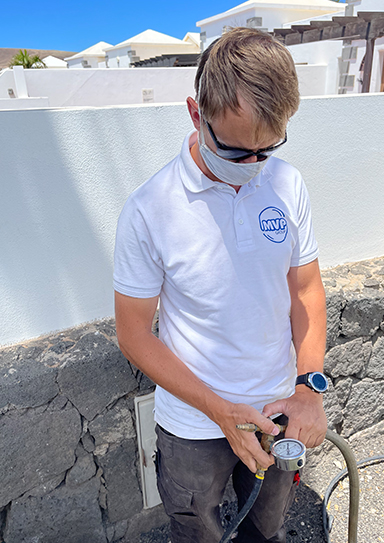Lots of people who live in Lanzarote have a swimming pool. It’s ideal for splashing around in the summer months, and the kids will go in for a dip at almost any time of year.
However, one of the things that all pool owners dread is suffering a pool leak in Lanzarote. All pools will lose a certain amount of water as a result of evaporation, and they also lose water as a result of splashing, but a pool leak in Lanzarote can be an entirely different issue.
However, if the loss of water in the pool is not for either of those reasons, then it’s certain that something, somewhere, is leaking. But where and what?
In some instances, there may be water pooling in the garden. You could have wet and mushy grass, or there could be cracked concrete or tiles. Varying chemical levels are another sign that there may be a leak in your pool or the surrounding pipe system, because keeping them correct when you are constantly adding water to the pool can be tricky. If you are losing more than ½ an inch a day, it is likely to be a leak. You might also notice that your water bill is going up.
The Bucket Test
First of all, you need to rule out normal evaporation, and you can do this by using the bucket test which is very simple. Take a 5-gallon bucket and fill it with pool water, marking the top of the waterline with some duct tape. At the same time mark the top of the waterline in the pool with another piece of tape. Leave the bucket next to the pool for a couple of days. Then measure the difference between the two lines of tape. If there is a noticeable difference between the two levels, then it is not likely to be evaporation, so the alternative is odds-on to be a leak.
Another thing to look for is a leak in the equipment pad. If a part has failed or a seal has broken, then water could be leaking into the pad, although it might not be immediately visible. You will need to check this for a few days. There could be issues with heaters, valves, pumps, or filters. When checking the equipment pad you need to be extremely careful in case an electrical wire has become exposed and is wet. It could give you a nasty shock.
Another test you can do is to check for leaks in the pool with a dye or food colouring. Where there are plumbing fixtures or integrated parts you can squirt a little dye into the water. If you have a leak around a drain or pump, you will see the dye or food colouring being pulled towards it. It’s best to wear goggles while doing this so that you can easily see what is happening.
You could also have a leaking liner. Sometimes these can be repaired, but if your vinyl liner is older, it may not be possible, so the answer would be to replace it with a new one.
Of course, the leak could also be in the underground pipework and for this you will need a specialist such as ourselves at CanaryDetect. We have all of the latest high-tech equipment that allows us to identify and locate pool leaks wherever they may be.
You will need to call us anyway, in order to repair the leak, whatever and wherever it may be, so if you have ruled out evaporation, it will be much quicker and easier to have us locate it for you in the first place, and then we can repair it for you if you wish us to.

